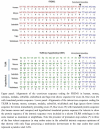Bioinformatics Analysis of the FREM1 Gene-Evolutionary Development of the IL-1R1 Co-Receptor, TILRR
- PMID: 24832504
- PMCID: PMC4009816
- DOI: 10.3390/biology1030484
Bioinformatics Analysis of the FREM1 Gene-Evolutionary Development of the IL-1R1 Co-Receptor, TILRR
Abstract
The TLRs and IL-1 receptors have evolved to coordinate the innate immune response following pathogen invasion. Receptors and signalling intermediates of these systems are generally characterised by a high level of evolutionary conservation. The recently described IL-1R1 co-receptor TILRR is a transcriptional variant of the FREM1 gene. Here we investigate whether innate co-receptor differences between teleosts and mammals extend to the expression of the TILRR isoform of FREM1. Bioinformatic and phylogenetic approaches were used to analyse the genome sequences of FREM1 from eukaryotic organisms including 37 tetrapods and five teleost fish. The TILRR consensus peptide sequence was present in the FREM1 gene of the tetrapods, but not in fish orthologs of FREM1, and neither FREM1 nor TILRR were present in invertebrates. The TILRR gene appears to have arisen via incorporation of adjacent non-coding DNA with a contiguous exonic sequence after the teleost divergence. Comparing co-receptors in other systems, points to their origin during the same stages of evolution. Our results show that modern teleost fish do not possess the IL-1RI co-receptor TILRR, but that this is maintained in tetrapods as early as amphibians. Further, they are consistent with data showing that co-receptors are recent additions to these regulatory systems and suggest this may underlie differences in innate immune responses between mammals and fish.
Figures






Similar articles
-
The Potential Role of FREM1 and Its Isoform TILRR in HIV-1 Acquisition through Mediating Inflammation.Int J Mol Sci. 2021 Jul 22;22(15):7825. doi: 10.3390/ijms22157825. Int J Mol Sci. 2021. PMID: 34360591 Free PMC article. Review.
-
The IL-1RI Co-Receptor TILRR (FREM1 Isoform 2) Controls Aberrant Inflammatory Responses and Development of Vascular Disease.JACC Basic Transl Sci. 2017 Aug 28;2(4):398-414. doi: 10.1016/j.jacbts.2017.03.014. eCollection 2017 Aug. JACC Basic Transl Sci. 2017. PMID: 28920098 Free PMC article.
-
Toll-like Interleukin 1 Receptor Regulator Is an Important Modulator of Inflammation Responsive Genes.Front Immunol. 2019 Feb 28;10:272. doi: 10.3389/fimmu.2019.00272. eCollection 2019. Front Immunol. 2019. PMID: 30873160 Free PMC article.
-
Development of monoclonal antibodies to interrogate functional domains and isoforms of FREM1 protein.Monoclon Antib Immunodiagn Immunother. 2014 Apr;33(2):129-40. doi: 10.1089/mab.2013.0058. Monoclon Antib Immunodiagn Immunother. 2014. PMID: 24746155
-
Innate immunity of finfish: primordial conservation and function of viral RNA sensors in teleosts.Fish Shellfish Immunol. 2013 Dec;35(6):1689-702. doi: 10.1016/j.fsi.2013.02.005. Epub 2013 Feb 24. Fish Shellfish Immunol. 2013. PMID: 23462146 Review.
Cited by
-
The Potential Role of FREM1 and Its Isoform TILRR in HIV-1 Acquisition through Mediating Inflammation.Int J Mol Sci. 2021 Jul 22;22(15):7825. doi: 10.3390/ijms22157825. Int J Mol Sci. 2021. PMID: 34360591 Free PMC article. Review.
-
TILRR (Toll-like Interleukin-1 Receptor Regulator), an Important Modulator of Inflammatory Responsive Genes, is Circulating in the Blood.J Inflamm Res. 2021 Sep 24;14:4927-4943. doi: 10.2147/JIR.S325553. eCollection 2021. J Inflamm Res. 2021. PMID: 34594127 Free PMC article.
-
The IL-1RI Co-Receptor TILRR (FREM1 Isoform 2) Controls Aberrant Inflammatory Responses and Development of Vascular Disease.JACC Basic Transl Sci. 2017 Aug 28;2(4):398-414. doi: 10.1016/j.jacbts.2017.03.014. eCollection 2017 Aug. JACC Basic Transl Sci. 2017. PMID: 28920098 Free PMC article.
-
The Effect of Heparin and Other Exogenous Glycosaminoglycans (GAGs) in Reducing IL-1β-Induced Pro-Inflammatory Cytokine IL-8 and IL-6 mRNA Expression and the Potential Role for Reducing Inflammation.Pharmaceuticals (Basel). 2024 Mar 14;17(3):371. doi: 10.3390/ph17030371. Pharmaceuticals (Basel). 2024. PMID: 38543157 Free PMC article.
References
-
- Bowie A., O’Neill L.A.J. The interleukin-1 receptor/toll-like receptor superfamily: Signal generators for pro-inflammatory interleukins and microbial products. J. Leukoc. Biol. 2000;67:508–514. - PubMed
Grants and funding
- PG/12/12/29433/BHF_/British Heart Foundation/United Kingdom
- BB/C515798/1/BB_/Biotechnology and Biological Sciences Research Council/United Kingdom
- PG/11/103/29219/BHF_/British Heart Foundation/United Kingdom
- BBS/B/04056/BB_/Biotechnology and Biological Sciences Research Council/United Kingdom
- G0700091/MRC_/Medical Research Council/United Kingdom
LinkOut - more resources
Full Text Sources

